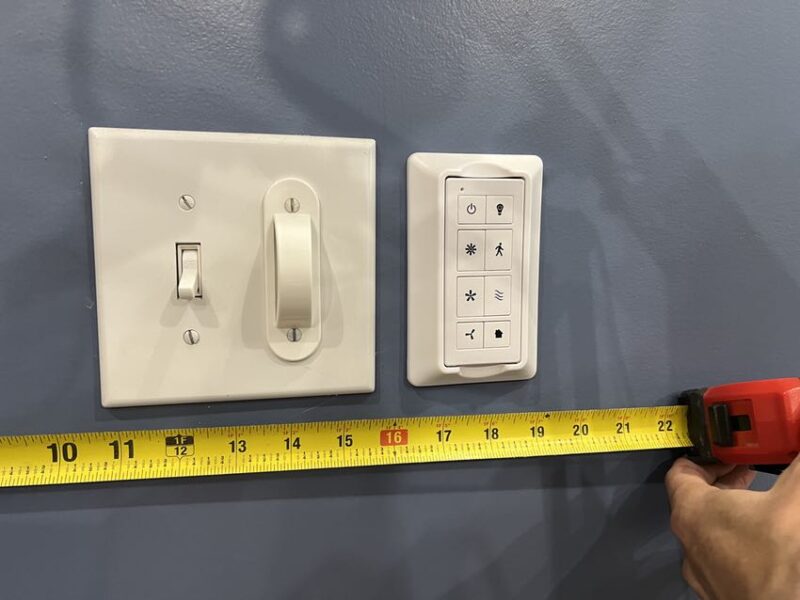When it comes to home improvement or even simple tasks like hanging a family portrait, knowing where your wall studs are located is paramount. Wall studs serve as the backbone of your walls, providing the necessary support and structure. Especially when you’re looking to hang heavier items, like a large mirror or a wall-mounted TV, anchoring them to a stud ensures they remain securely in place without causing any damage. It’s worth noting that in many homes, these studs are typically spaced about 16 inches apart. By understanding how to locate these hidden pillars, you can confidently make enhancements to your living space while ensuring safety and stability.
Methods to Find Wall Studs:
1. Locate the nearest light switch or power outlet
- Purpose: Electrical outlets and light switches often provide the first clue in the hunt for wall studs.
- Content:
- Most electrical boxes for switches or outlets are mounted directly to the side of a wall stud. By identifying the location of an outlet or switch, you’re essentially pinpointing the location of a stud.
- Once you’ve located an outlet or switch, take a ruler or tape measure and measure 16 inches horizontally from its edge. Given that many walls have studs spaced 16 inches apart, this measurement will likely lead you to the center of the next stud.
2. Look for dimples in the wall
- Purpose: The wall itself can sometimes give away the location of its studs.
- Content:
- If you observe closely, you might notice slight indentations or dimples on the wall. These are spots where the drywall is fastened to a stud.
- To make these dimples more visible, especially in dimly lit areas, shine a flashlight parallel to the wall. The light will cast shadows, making the dimples stand out.
3. Use windows as a guide
- Purpose: Windows offer a clear reference point in the search for studs.
- Content:
- Typically, there’s a stud situated on both sides of a window. These studs provide the necessary framework and support for the window.
- Starting from the edge of the window, measure 16 inches horizontally. This measurement should lead you to an adjacent stud, given the common 16-inch spacing.
4. Tap the wall
- Purpose: Your own sense of sound can be a tool in locating studs.
- Content:
- By gently tapping or knocking on the wall with your knuckles, you can listen for the difference in sound. A hollow sound indicates a space between studs, while a solid or muffled sound is a good indicator of a stud’s presence.
5. Drill a hole
- Purpose: For those who want certainty, a drill can provide a definitive answer.
- Content:
- Carefully drill a small hole in the wall where you suspect a stud might be. If the drill meets resistance shortly after penetrating the drywall, you’ve hit wood, indicating the presence of a stud.
6. Fish around with a wire hanger
- Purpose: Sometimes, unconventional methods can yield results.
- Content:
- Straighten out a wire hanger and then bend a small hook at one end. Insert the straight end into a small hole in the wall and rotate it. If the hook end hits something solid, you’ve likely found a stud.
7. Try a stud finder app
- Purpose: Technology offers modern solutions for age-old problems.
- Content:
- There are several smartphone apps available that utilize the phone’s built-in magnetometer to detect metal objects, like screws or nails, in the wall.
- However, it’s essential to approach results with caution. These apps can sometimes give false positives by detecting other metal objects, such as pipes or wires.
8. Use a stud finder gadget
- Purpose: Specialized tools can simplify the task.
- Content:
- Handheld stud finders are devices specifically designed to locate studs behind walls. They work by detecting changes in wall density.
- To use one, place it flat against the wall and move it horizontally. The device will typically light up or beep when it detects a stud.
Conclusion
Locating wall studs accurately is more than just a step in the home improvement process; it’s a fundamental aspect of ensuring safety and durability in your living space. As we’ve explored, there are various methods to pinpoint these hidden pillars, each with its own advantages. Before you embark on any project, whether it’s hanging a cherished family portrait or installing a new shelf, confirming the location of a stud is paramount. Failing to do so can lead to potential risks, including damage to your walls or, even worse, items falling due to lack of support. In essence, taking the time to find wall studs is a small effort that guarantees peace of mind and the longevity of your wall-mounted additions.

